Keywords
Pisi baligi, Platichtys flesus luscus, Cinsiyet orani, Mevsimsel degisim
Introduction
The flounder, Platichtys flesus luscus, is one of the most commercially important flatfishes in the Black Sea coastal waters of Turkey. The species is widely distributed in the Atlantic, the western Mediterranean, the Adriatic Sea, the Aegean Sea and also the Marmara Sea, Black Sea and Azov Sea (Borsa et al. 1997).
The Black Sea’s fisheries have deteriorated dramatically in the past three decades and the diversity of commercial fish caught has decreased over this period from about 26 species to six. The flounder population, an important species for the Black Sea’s icthyofauna in the 1960s, has also decreased (Zaitsev et al. 1997).
Although, there have been several studies on age and growth (Draganik and Kusczynski, 1993; Samsun, 1995; Özdamar et al. 1995), feeding habits (Fonds et al. 1992; Seyhan et al., 1996), genetic structure (Borsa et al., 1997) and mating behavior (Kosior et al., 1996) in other regions, there is no record about the seasonal variation of flounder in this area. The parameter values of the stock should be also examined because these values for the species would be varied depending upon the ecological circumstance which differs among regions,
The aim of the present study was to determine the length, weight and sex distribution of flounder caught by bottom trawl in the south-eastern Black Sea, according to seasons. These data can be useful for improving the management of the whole flounder population.
Materials and Methods
The study was carried out between 41º03´ N latitude and 39º45´ E longitude, on the south-eastern Black Sea coast (mainly oof-Trabzon) of Turkey. 1598 individuals were collected with a trawl net (14 mm codend mesh size) by the research vessel of the Central Fisheries Research Institute (CFRI) during a survey conducted monthly intervals at a depth of 15-90 m off Trab-zon, Turkey, between August 1995 and August 1996, and each hauling time was normally restricted to 30 min.
The sexes were determined after dissection. Fish were sexed by simple visual observation of the gonad’s physical appearence (Holden and Raitt, 1974). Weights of gonads were determined (nearest 0.001 g) after blotting blood and water. Additionally, total length (L), and body weight (W) were measured with 1 mm and 0.01 g precision in fresh samples, respectively.
The relationship between length and weight was established as;
W = a Lb,
where W is body weight (g), L is total length (cm), and a and b are coefficients of the functional regression between W and L (Ricker, 1975).
The observed differences were evaluated statistically using one-way ANOVA and Student’s t-test. A chi-square (χ2) test was used to detect differences in the sex ratios. Comparisons of length frequency distributions among seasons were carried out using the Kolmogorov-Smirnov test (Zar, 1999).
Results and Discussion
A total of 1598 flounder specimens were examined. The size ranges were 11.2-38.2 cm and 17.9-614.0 g, and 12.0-27.9 cm and 9.2-262.5 g for female and male, respectively. The mean total length and weight were 27.6±3.61 cm and 248.0±91.25 g for females (n = 762), 21.1±1.86 cm and 103.4±27.23 g for males (n = 836), and 24.2±4.30 cm and 172.1±97.88 g for all individuals.
The catch frequencies were 15.4%, 11.7%, 39.5%, and 33.4% for autumn, winter, spring, and summer, respectively (Figure 1). The samples that were 21 cm in length were abundant in autumn (13.8%), spring (15.5%), summer (16.5%), and total length of 26 cm were abundant in winter (13.8%) (Figure 2). In the overall samples of males and females 21 (26.1%) and 27 (16.5%) cm in length were abundant, respectively (Figure 3).
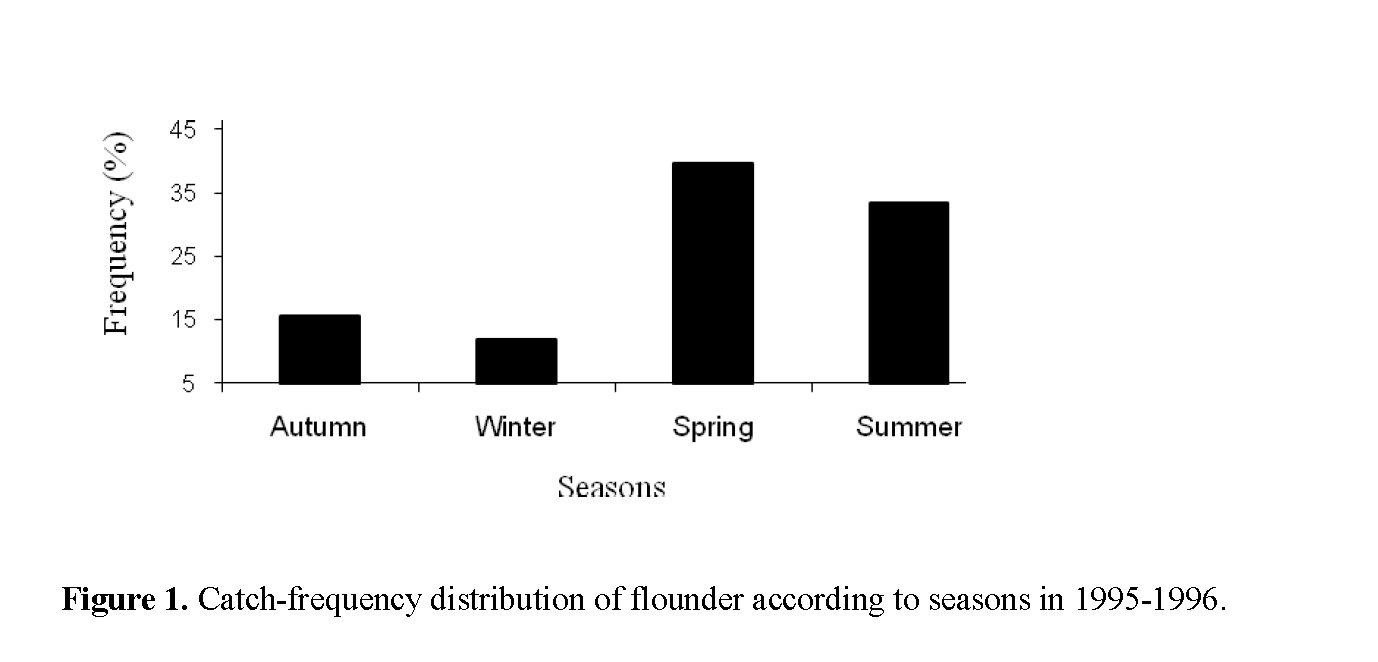
Figure 1: Catch-frequency distribution of flounder according to seasons in 1995-1996.
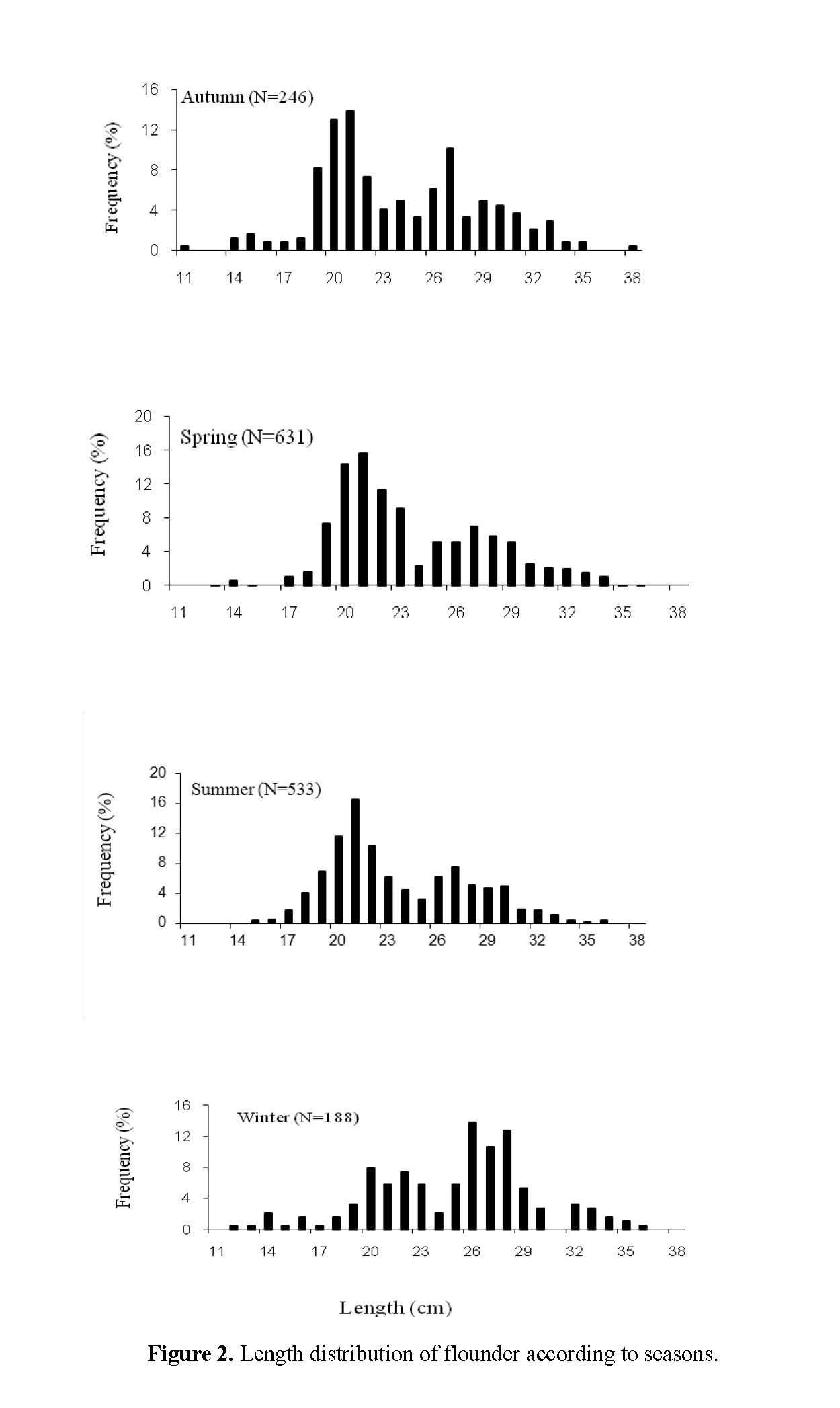
Figure 2: Length distribution of flounder according to seasons.
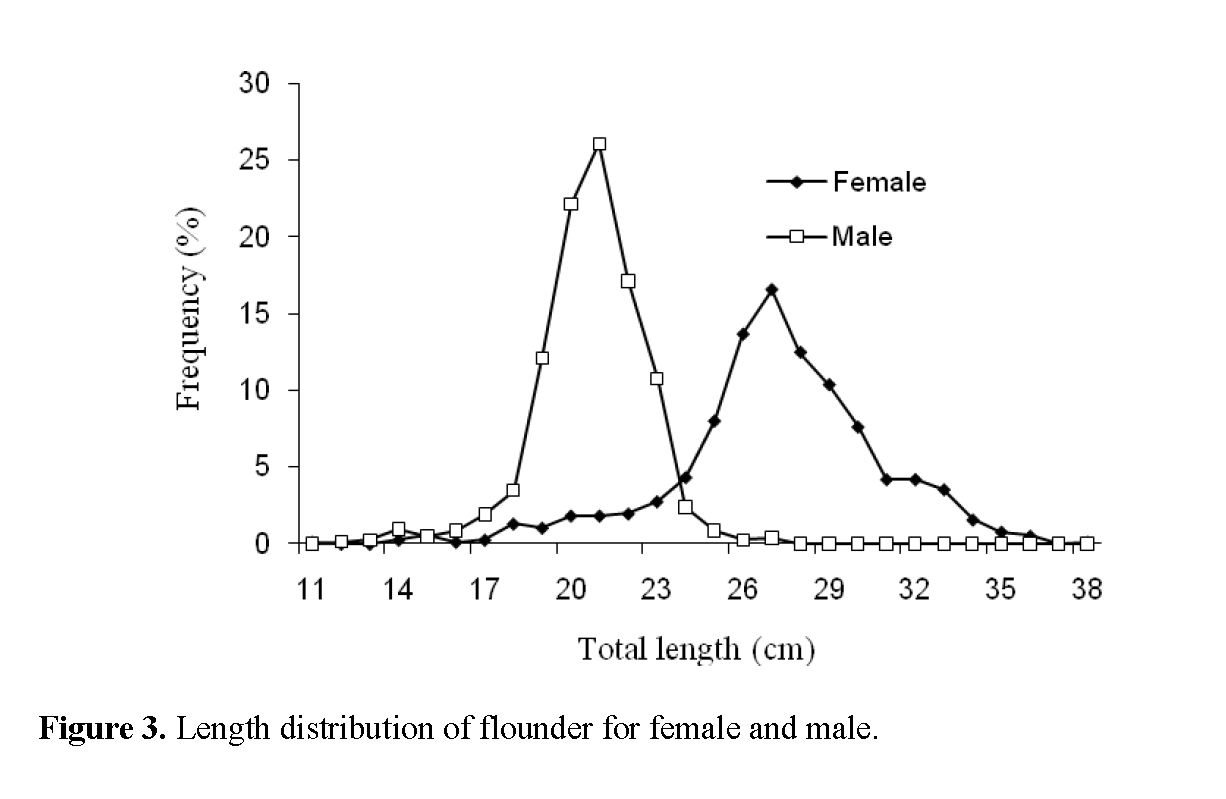
Figure 3: Length distribution of flounder for female and male.
Differences in length among seasons were not statistically significant, except winter (P > 0.05). Moreover, there were significant differences in weight between autumn-spring, and autumn-summer (P < 0.05). The length and weight of flounder differed significantly between the sexes (P < 0.05) (Figure 3). The length frequencies of flounder differed significantly among seasons (P<0.001).
The female-male ratios of flounder were 52.9%-47.1%, 66.5%-33.5%, 42.6%-57.4%, and 47.7%-52.3% in autumn, winter, spring, and summer, respectively (Table 1). There were significant differences between the sex ratios in winter in favor of females (P<0.05).
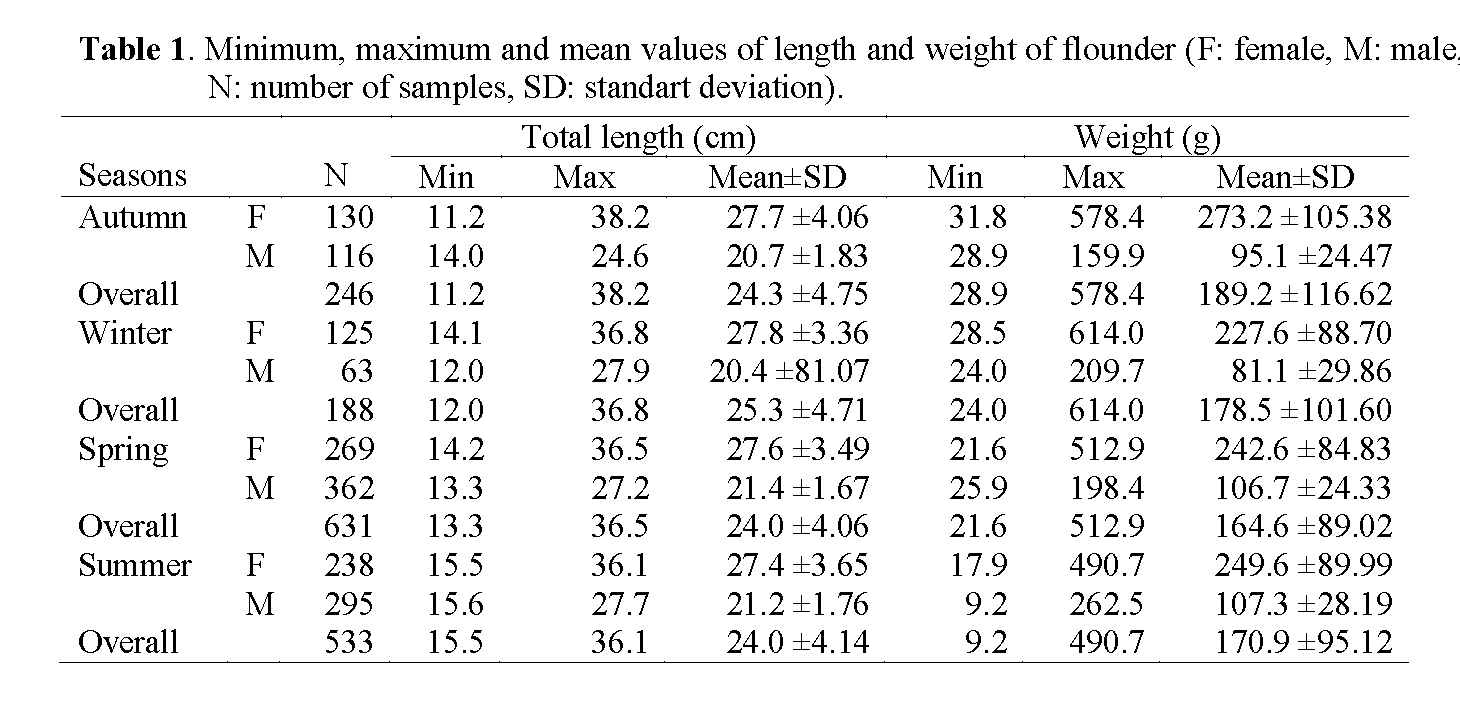
Table 1: Minimum, maximum and mean values of length and weight of flounder (F: female, M: male, N: number of samples, SD: standart deviation).
The relationship between total length and body weight for females, and males were W=0.0184 * L2.8485 (r=0.90), and W=0.0202 * L2.7898 (r=0.87), respectively (Figure 4). The slopes (b values) of the length-weight regressions did not differ significantly between the sexes (P>0.05). A negative allometric growth was observed for flounder females and males.
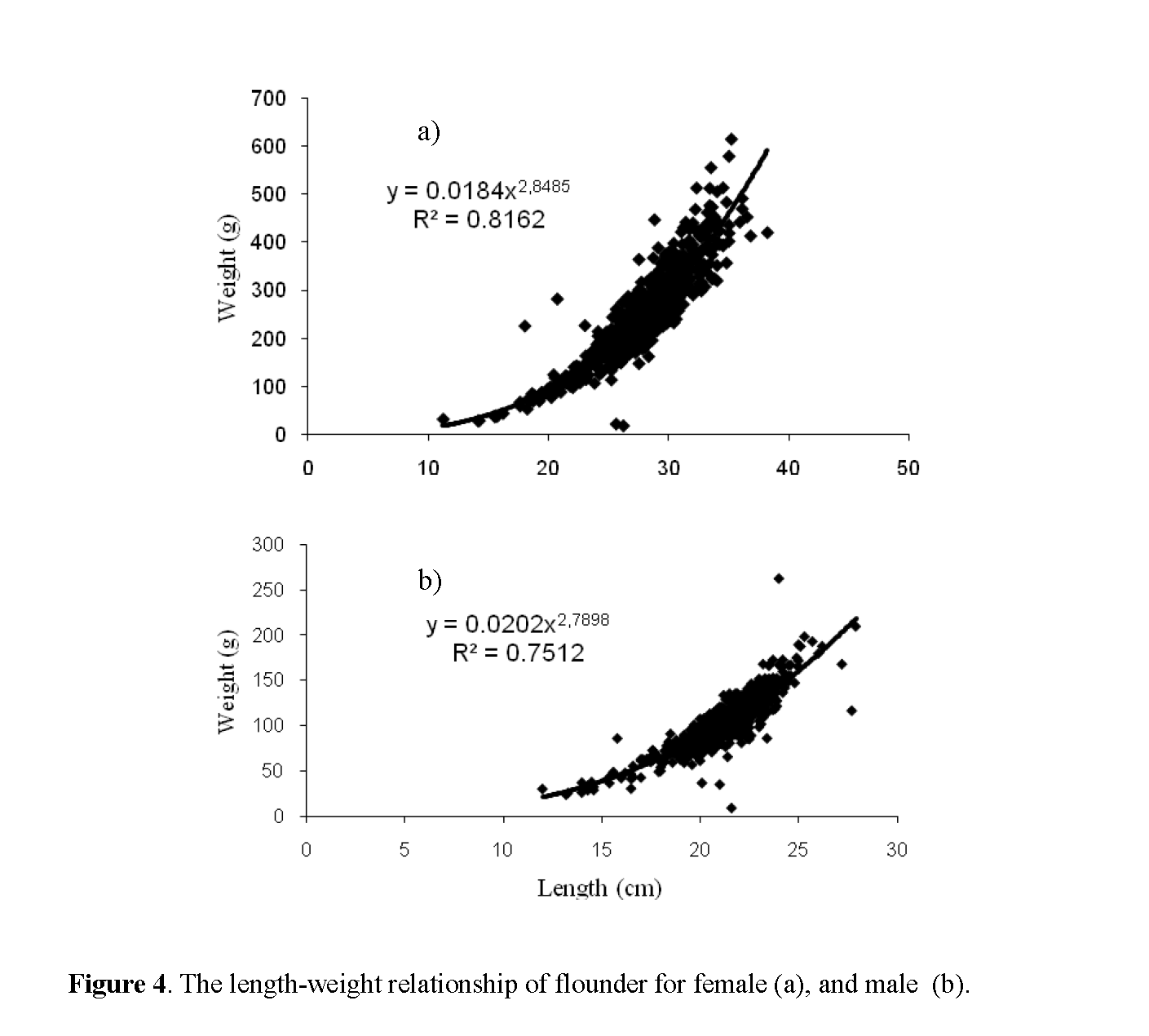
Figure 4: The length-weight relationship of flounder for female (a), and male (b).
Several researchers have reported different lengths and weights of flounder in the Black Sea. The average lengths and weights reported were 18.8 cm by Slastenenko (1956), 20.3 cm, 104.2 g by Samsun (1995), 20.4 cm, 103.1 g by Özdamar et al. (1995), and 22.9 cm, 153.8 g by Seyhan et al. (1996). In the present study the average lenght and weight was found 24.2 cm and 172.1 g, respectively. The differences among the studies probably depend on selectivity of fishing gear and the sampling areas. During spring and summer, flounder fishing intensifies when the temperature increases. From March to the end of August, an average of 72.9% was sampled in the eastern Black Sea. The maximum average flounder lengths were recorded in winter.
Maximum flounder lengths vary according to species, and the areas studied. In other words, the maximum length for P. flesus luscus in the Black Sea was 40 cm according to Slastenenko (1956). The maximum length of Pleuronectes platessa in the North Sea was 45 cm for males and 60 cm for females (Bannister, 1978). The maximum length of 38.2 cm in the present study was smaller than the lengths for the same specis (Slastenenko, 1956), and for Pleuronectes platessa (Bannister, 1978).
Differences in growth between females and males were also observed in this study, with females significantly longer than males. Referencing many studies on flounder, females always had a higher growth rate and greater length, and they were older than males (Slastenenko, 1956; Bannister, 1978; Özdamar et al., 1995; Samsun, 1995; Seyhan et al., 1996). Flounder is a good example of a species where growth in length and especially growth in weight increases with salinity (Sager and Berner 1989; Drevs et al.1999). Growth in females is distinctly faster than in males (Molander 1938, Sager and Berner 1989; Drevs et al.1999).
Rjinsdorp and Ibeling (1989) reported that the total increase in somatic weight and gonad weight of both males and females matches their increase to a particular size, but, after reaching that size, female flatfish have greater surplus energy than males. The highest percentage of female flounders was determined to be 66.5% in winter, significantly favoring females over males with a higher percentage. In a recent study the female ratio in the Black Sea was documented as 49.4% (Samsun, 1995), and 51.0% (Özdamar et al, 1995). Although gender ratios in the spawning population in different age and size groups vary according to species, reflecting the relationship of that species to its environment, the overall gender ratio is close to 1:1 in many species (Bagenal and Tesch, 1978).
The value of b was found to be smaller than 3 for female and male samples, which indicated that flounder growth had a negative allometry. Similar results have been reported from the same area by Seyhan et al. (1996). In contrast, Samsun (1995) and Özdamar et al. (1995) found positive allometric growth in the central Black Sea coast. Ricker (1975) reported that the b-value represents the body form and is directly related to the weight affected by ecological factors. A series of factors such as season, habitat, gonad maturity, sex, diet, stomach fulness, health, and annual differences in environmental conditions, can also affect the value of b (Bagenal and Tesch 1978). Growth parameters differ from species to species and also stock to stock even within the same species as a result of different environmental conditions (Sparre et al., 1989).
Conclusion
In conclusion, significant differences were found both in length and weight values of flounder between seasons. During spring and summer, flounder fishing intensifies when the temperature increases. From March to the end of August, an average of 72.9 % was sampled in the eastern Black Sea. The flounder, as one of the flatfish species, has an important place in the Turkish fishing industry. To preserve and maintain these valuable stocks, harvesting flounder smaller than 20 cm, the minimum legal fishing size, must be prevented, and fishermen must comply with the seasonal limitations and net regulations.
1021
References
- Bagenal, T.B., Tesch, F.W., (1978). Age and growth. In: Bagenal T.B. (Ed.), Methods for Assessment of Fish Population in Fresh Waters, IBP Handbook, Vol. 3 London, Blackwell Scientific Publications, Oxford, pp. 101-136.
- Bannister, R.C.A., (1978). Changes in plaice stocks and plaice fisheries in the North Sea. Rapports et Proces-Verbaux des Reunions - Conseil International pour l'Exploration de la Mer, 172: 86-101.
- Borsa, P., Blanquer, A., Berrebi, P., (1997). Genetic structure of the flounders Platichthys flesus and P. stellatus at different geographic scales. Marine Biology, 129: 233-246.
- Draganik, B., Kusczynski, J., (1993). A review of growth rate of the Baltic flounder (Platichthys flesus (L.)) derived from otolith measurements. Bulletin of the Sea Fisheries Institute, 3(130): 21-36.
- Drevs, T., Kadakas, V., Lang, T., Mellergaard, S., (1999). Geographical variation in the age/length relationship in Baltic flounder (Platichthys flesus). ICES Journal of Marine Science, 56: 134-137.
- Fonds, M., Cronie, R., Vethaak, A.D., (1992). Metabolism, food consumption and growth of plaice (Pleuronectes platessa) and flounder (Platichthys flsus) in relation to fish size and temperature. Nedherlands Journal of Sea Research, 29(1-3): 127-143. doi: 10.1016/0077-7579(92)90014-6
- Holden, M.J. Raitt, D.F.J., (1974). Manual of Fisheries Science. FAO, 214 pp.
- Kosior, M., Grygiel, W., Kusczynski, J., (1996). Changes in the absolute fecundity of the southern Baltic flounder, Platichthys flesus (L.). Bulletin of the Sea Fisheries Institute, 2(138): 15-27.
- Molander, A.R., (1938). Investigations into the growth-rates of the common dab and the flounder in the southern Baltic. Rapports et Proces-Verbaux des Reunions - Conseil International pour l'Exploration de la Mer, 14: 90-101.
- Özdamar, E., Samsun, O., Erkoyuncu, Ü., (1995). Karadeniz Demersal Türlerinden Pisi Bali-ginin (Platichthys flesus luscus Pallas, 1811) 1994-995 Av Sezonu Için Bazi Populasyon Parametrelerinin Tahmini, II. National Fisheries Symposium, Erzurum, Turkey.
- Rijnsdorp, A.D., Ibelins, B., (1989). Sexual dimorphism in the energetic of reproduction and growth of North Sea plaice, Pleurunectes platessa L. Journal of Fish Biology, 35: 401-415.
- Ricker, W.E., (1975). Computation and interpretation of biological statistics of fish population. Bulletin Fisheries Research Bo-ard of Canada, 191: 1-382.
- Sager, G., Berner, M., (1989). Investigations of growth in length and weight of three flatfish species in the Baltic. Rapports et Proces-Verbaux des Reunions - Conseil International pour l'Exploration de la Mer, 190: 105–108.
- Samsun, O., (1995). Orta Karadeniz’de (Türkiye) Avlanan Pisi (Platichtys flesus luscus Pallas,1811) Baliginin Balikçilik Biyolojisi Yönünden Arastirilmasi. Journal of Fisheries and Aquatic Sciences, 12: 21-26.
- Seyhan, K., Düzgünes, E., Zengin, M., (1996). Feeding ecology and population parameters of sole, turbot and flounder in the eastern Black Sea. Third International Symposium on Flatfish Ecology, Nederland.
- Slastenenko, E., (1956). The Fishes of Black Sea Region. Meat and Fish Association General Directorate Publications, Istanbul, 711 pp. (in Turkish).
- Sparre, P., Ursin, E., Venema, S.C., (1989). Introduction to Tropical Fish stock Assessment. Part 1, Manual, FAO Fish. Tech. Paper, No. 306-1, FAO, Rome, 337 pp.
- Zaitsev, Y., Mamaev, V., (1997). Biological Diversity in the Black Sea, Black Sea Environmental Series, New York, Vol. 3: 14-17, 105- 127.
- Zar, J.H., (1999). Biostatistical Analysis. 4th edition, Prentice-Hall, Englewood Cliffs, New Jersey.











